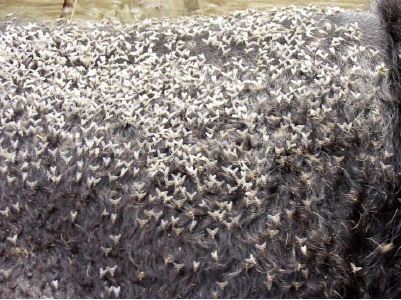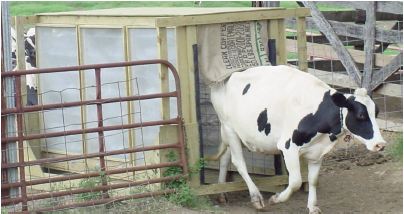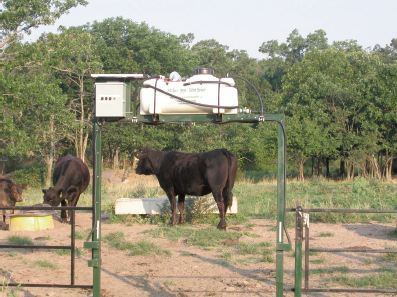



The Importance of Controlling Horn Flies
Causing a seasonal spike in mastitis, Horn fly is the most ecologically important cattle insect pest in Arkansas.At this point in the year Horn fly Haematobia irritans could require treatment, advises Dr Kelly Loftin, Extension Entomologist at Arkansas State University.
A horn fly is about half the size of a house fly and spends most of its time on the back, head and shoulders of its host. They also feed on the belly and legs. In addition to being smaller than the house fly, horn flies can be differentiated by piercing mouthparts that resemble a beak. Horn flies briefly leave the animal to deposit eggs on fresh cattle manure (less than 10 minutes old).
Both sexes feed on cattle and take 20 to 40 blood meals per day. Although rare, populations of up to 10,000 per animal have been documented.

Development from egg to adult requires as little as 9 to 12 days, writes Dr Loftin. Larva hatch and develop within the manure. Mature larvae migrate to the lower portion of the manure pat or in the soil to pupate. Adults immerge from pupa after about 5 or 6 days.
Horn flies survive the winter as pupae in the soil. After the adult emerges, it seeks a host to begin blood feeding. An adult female may begin laying eggs three days after emergence and may lay up to 400 eggs during her lifetime. With such a short life cycle, several generations per year are possible, allowing this pest to develop insecticide resistance.
In Arkansas, two seasonal population peaks occur, one in the late spring and one in the late summer or early fall. Complete elimination of horn flies is impractical and impossible. Most research suggests that economic damage occurs in dairy cattle when 75 to 100 horn flies per animal are present. For beef cattle, this threshold is about twice (150 to 200) that number.

Monitoring horn fly populations is important in managing this pest. Populations are monitored by counting the number of horn flies on the heads, shoulders and backs of at least 10 cows. Average counts approaching 75 to 100 horn flies per animal (dairy cattle) indicate that economic loss may occur and that control measures are necessary.
Horn fly control methods vary widely. Insecticide-impregnated ear tags, self-treatment devices such as back rubbers and dust bags, pour-on insecticides and sprays are the most common method of applying contact insecticides. Other methods include feed additives containing insect growth regulators, walk-through sprayers and walk-through traps.

The walk-through trap is a nonchemical method that traps flies that are brushed off the Insecticide-impregnated ear tags are economical, easy to use and can provide long-term control. As a result of these attributes, ear tags are often overused or misused, resulting insecticide-resistant horn flies.
This misuse and other factors, such as the short generation time (2 weeks) and multiple generations per season (~10), contribute to insecticide resistance potential. The active ingredients of insecticide-impregnated ear tags fall into three insecticide classes: synthetic pyrethroids, organophosphates and macrocyclic lactones.
To mitigate potential insecticide resistance, rotate insecticide class and remove ear tags at the end of the fly season or when they fail. Also, if ear tags are applied too early, they may fail late in the animal as it passes through the trap. The walk-through sprayer (3-D Quik Hand Cattle Sprayer) sprays the animal as it passes through the sprayer. Both walk-through methods are well suited for some dairy operations. season because of normal loss of insecticide activity or possible resistance.
Remember to study the label prior to insecticide purchase and use. Some insecticides registered to use on beef cattle or non-lactating dairy cattle cannot be used on lactating dairy cattle. The animal sections of MP144, Insecticide Recommendations for Arkansas, and FSA7031, Controlling Horn Flies on Cattle, provide more detailed information on insecticides and horn fly control. Both are available at your county Extension office or online at http://www.uaex.edu/publications/mp-144.aspx (MP144) and http://www.uaex.edu/publications/PDF/FSA-7031.pdf
(FSA7031), respectively.


